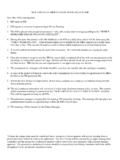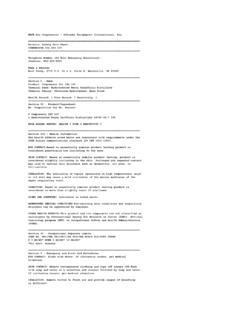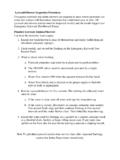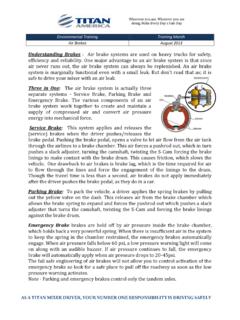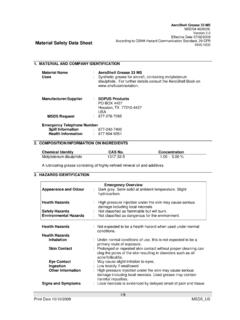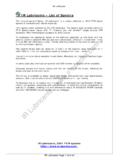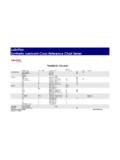Transcription of AeroShell Grease 5 - S&W Ready Mix Concrete
1 Safety Data SheetAeroShell Grease 51. IDENTIFICATION OF THE SUBSTANCE/PREPARATION AND COMPANY/UNDERTAKINGP roduct Code001A0063 Infosafe GB/eng/CIssued Date16/05/2003 Product Type/UseMineral Grease for aircraft. For further details consult the AeroShell Book NamesNameCodeAeroShell Grease 5140001168121 SupplierTelephone NumbersSHELL UK PRODUCTS LTDS tanlow Manufacturing ComplexPO Box 3 Ellesmere PortCH65 4 HBTechnical Contact: Product HSED epartmentUnited KingdomEmergency NumberTel: 0151-350-40002. COMPOSITION/INFORMATION ON INGREDIENTSP reparation DescriptionHighly refined mineral oil Grease thickened with clay, containing additives. The highly refined mineral oilcontains <3% (w/w) DMSO-extract, according to Components / ConstituentsExposure limits apply to the following components: Highly refined mineral HAZARDS IDENTIFICATIONEC ClassificationNot classified as Dangerous under EC Health HazardsNo specific hazards under normal use conditions.
2 Prolonged or repeated exposure to skin may give rise todermatitis. Used Grease may contain harmful HazardsNot classified as flammable, but will Grease 5 Version No. 16/05/2003 Page 1 of 9 Environmental HazardsNot classified as dangerous for the FIRST AID MEASURESS ymptoms and EffectsNot expected to give rise to an acute hazard under normal conditions of the unlikely event of dizziness or nausea, remove casualty to fresh air. If symptoms persist, obtain contaminated clothing and wash affected skin with soap and water. If persistent irritation occurs, obtainmedical attention. If high pressure injection injuries occur, obtain medical attention eye with copious quantities of water.
3 If persistent irritation occurs, obtain medical out mouth with water and obtain medical attention. Do not induce to DoctorTreat symptomatically. Aspiration into the lungs may result in chemical pneumonitis. Dermatitis may result fromprolonged or repeated pressure injection injuries require surgical intervention and possibly steroid therapy to minimise tissuedamage and loss of function. Because entry wounds are small and do not reflect the seriousness of theunderlying damage, surgical exploration to determine the extent of involvement may be necessary. Localanaesthetics or hot soaks should be avoided because they can contribute to swelling, vasospasm andischaemia. Prompt surgical decompression, debridement and evacuation of foreign material should beperformed under general anaesthetics, and wide exploration is essential.
4 There may be a risk to health wherelow viscosity products are aspirated into the lungs following vomiting, although this is uncommon in adults. Suchaspiration would cause intense local irritation and chemical pneumonitis. Children, and those in whomconsciousness is impaired, will be more at risk. Emesis of lubricants is not usually necessary, unless a largeamount has been ingested, or some other compound has been dissolved in the product. If this is indicated, forexample, when there is rapid onset of central nervous system depression from large ingested volume - gastriclavage under controlled hospital conditions, with full protection of the airway is required. Supportive care mayinclude oxygen, arterial blood gas monitoring, respiratory support, and, if aspiration has occurred, treatment withcorticosteriods and antibiotics.
5 Seizures should be controlled with Diazepam, or appropriate equivalent FIRE FIGHTING MEASURESS pecific HazardsCombustion is likely to give rise to a complex mixture of airborne solid and liquid particulates and gases,including carbon monoxide and unidentified organic and inorganic MediaFoam and dry chemical powder. Carbon dioxide, sand or earth may be used for small fires Extinguishing MediaWater in jet. Use of halon extinguishers should be avoided for environmental EquipmentProper protective equipment including breathing apparatus must be worn when approaching a fire in a Grease 5 Version No. 16/05/2003 Page 2 of 96. ACCIDENTAL RELEASE MEASURESP ersonal PrecautionsAvoid contact with skin and eyes.
6 Wear PVC, Neoprene or nitrile rubber gloves. Wear rubber knee length safetyboots and PVC Jacket and Trousers. Wear safety glasses or full face shield if splashes are likely to PrecautionsPrevent from spreading or entering into drains, ditches or rivers by using sand, earth, or other appropriatebarriers. Inform local authorities if this cannot be Methods - Small SpillagesDispose into a suitable, clearly marked container for disposal or reclamation in accordance with Methods - Large SpillagesAs for small HANDLING AND STORAGEH andlingUse local exhaust ventilation if there is risk of inhalation of vapours, mists or aerosols. Avoid prolonged orrepeated contact with skin. When handling product in drums, safety footwear should be worn and properhandling equipment should be used.
7 Prevent spillages. Cloth, paper and other materials that are used to absorbspills present a fire hazard. Avoid their accumulation by disposing of them safely and immediately. In addition toany specific recommendations given for controls of risks to health, safety and the environment, an assessmentof risks must be made to help determine controls appropriate to local circumstances. Exposure to this productshould be reduced as low as reasonably practicable. Reference should be made to the Health and SafetyExecutive's publication 'COSHH Essentials'.StorageKeep in a cool, dry, well-ventilated place. Use properly labelled and closeable containers. Avoid direct sunlight,heat sources, and strong oxidizing agents.
8 The storage of this product maybe subject to the Control of Pollution(Oil Storage) (England) Regulations. Further guidance maybe obtained from the local environmental Temperatures0 C Minimum. 50 C MaterialsFor containers or container linings, use mild steel or high density MaterialsFor containers or container linings, avoid InformationPolyethylene containers should not be exposed to high temperatures because of possible risk of EXPOSURE CONTROLS, PERSONAL PROTECTIONE xposure LimitsSubstanceRegulationsExposureDurati onExposure LimitUnitsNotesAeroShell Grease 5 Version No. 16/05/2003 Page 3 of 9 Oil mist, mineralHealth and SafetyExecutive. EH40;Occupational and SafetyExecutive.
9 EH40;Occupational Exposure InformationDue to the product's semi-solid consistency, generation of mists and dusts is unlikely to ControlsThe use of personal protective equipment is only one aspect of an integrated approach to the Control OfSubstances Hazardous to management of Health and Safety at Work Regulations 1992 require employers to identify and evaluate therisks to health and to implement appropriate measures to eliminate or minimise those risks. The choice ofpersonal protective equipment is highly dependent upon local conditions, exposure to other chemicalsubstances and micro-organisms, thermal hazards (protection from extremes of cold and heat), electricalhazards, mechanical hazards and appropriate degree of manual dexterity required to undertake an the content of this section may inform the choice of personal protective equipment used, the limitations ofany information which can be provided must be fully understood.
10 Personal protective equipment chosen toprotect employees from occasional splashes maybe entirely inadequate for activities involving partial orcomplete the levels of oil mist or vapour in air are likely to exceed the occupational exposurestandards then consideration should be given to the use of local exhaust ventilation to reduce choice of personal protective equipment should only be undertaken in the light of a full risk assessment bya suitably qualified competent person ( a professionally qualified occupational hygienist).Effective protection is only achieved by correctly fitting and well maintained equipment and employers shouldensure that appropriate training is given. All personal protective equipment should be regularly inspected andreplaced if defective.



